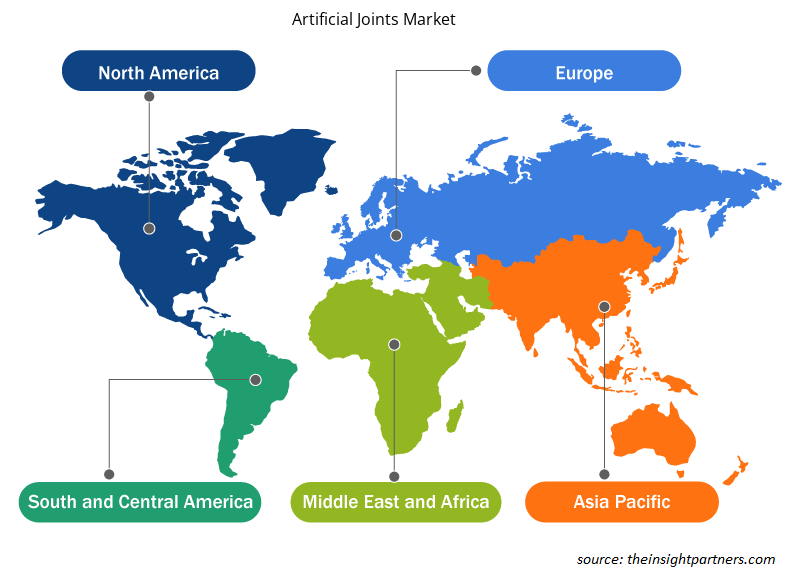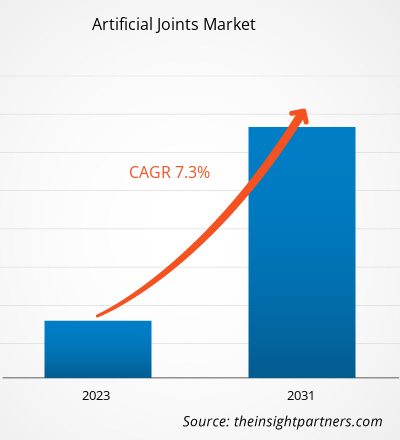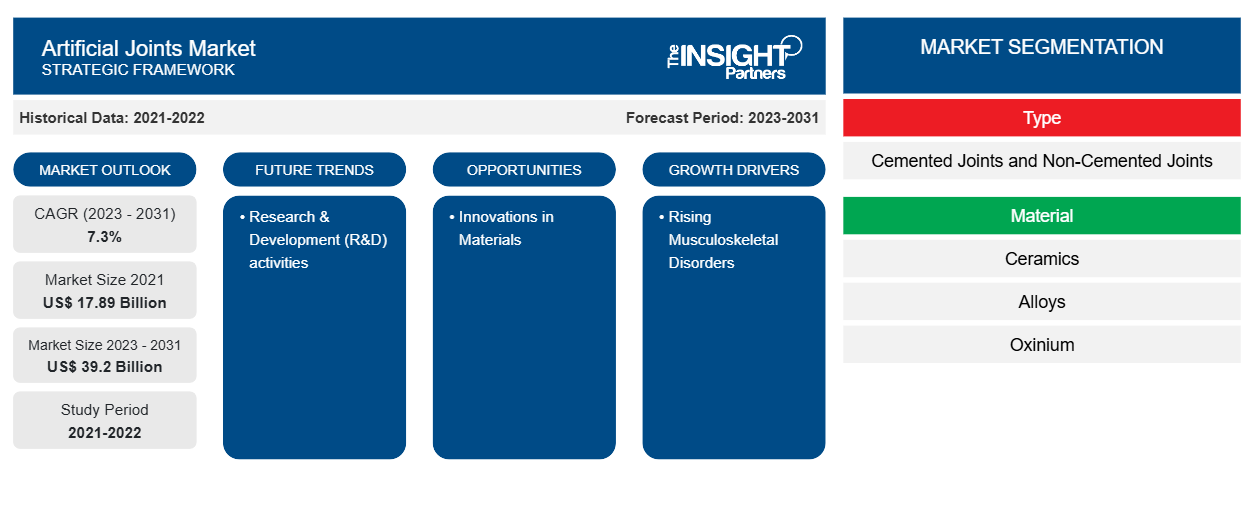Le marché des articulations artificielles était évalué à 17,89 milliards de dollars américains en 2021 et devrait atteindre 39,2 milliards de dollars américains d'ici 2031. Le marché devrait enregistrer un TCAC de 7,3 % entre 2023 et 2031. Les activités de recherche et développement (R&D) devraient rester les principales tendances du marché des articulations artificielles.JointsMarket was valued at US$ 17.89 billion in 2021 and is expected to reach US$ 39.2 billion by 2031. The market is expected to register a CAGR of 7.3% from 2023–2031. Research & Development (R&D) activities is likely to remain key Artificial Joints Market trends.
Analyse du marché des articulations artificielles
Augmentation des troubles musculo-squelettiques
Les prothèses articulaires sont devenues un facteur intrinsèque de maintenance et de restauration pour traiter un large éventail de problèmes musculo-squelettiques parmi les troubles musculo-squelettiques. Par exemple, en 2019, en Angleterre, plus de 200 000 prothèses de hanche et de genou ont été réalisées, dont 189 prothèses de hanche et 130 prothèses de genou. Par conséquent, avec l'augmentation des troubles musculo-squelettiques, il existe une demande accélérée d'articulations artificielles. Les articulations artificielles modernes sont des produits de haute technologie fabriqués à partir de matériaux spécialisés utilisant un équipement technologique unique. Ces conceptions sont justifiées et conçues sur la base de méthodes d'analyse du système, de l'état physiologique des patients et de l'élimination des complications. Par conséquent, le développement d'articulations artificielles modernes avec une option de chirurgie non invasive, moins douloureuse pour les patients, sont les facteurs les plus influents responsables de la croissance du marché des articulations artificielles au cours de la période 2021-2031.
Aperçu du marché des articulations artificielles
La technologie, l’innovation et les solutions technologiques intelligentes continuent d’influencer considérablement les articulations artificielles. L’augmentation des troubles musculo-squelettiques et les technologies intelligentes dans les articulations artificielles sont les facteurs les plus influents responsables de la croissance du marché des articulations artificielles. Les activités de recherche et développement (R&D) sont une tendance clé pour la croissance du marché des articulations artificielles. Les innovations dans les matériaux offriront des opportunités de marché lucratives.
Personnalisez ce rapport en fonction de vos besoins
Vous bénéficierez d'une personnalisation gratuite de n'importe quel rapport, y compris de certaines parties de ce rapport, d'une analyse au niveau des pays, d'un pack de données Excel, ainsi que de superbes offres et réductions pour les start-ups et les universités.
-
Obtenez les principales tendances clés du marché de ce rapport.Cet échantillon GRATUIT comprendra une analyse de données, allant des tendances du marché aux estimations et prévisions.
Articulations artificiellesMoteurs et opportunités du marché
Les technologies intelligentes dans les articulations artificielles vont favoriser le marché
Les fabricants veulent concevoir des implants orthopédiques intelligents qui surveillent la progression des patients. Webster est l'un de ces fabricants qui est en train de développer des implants orthopédiques intelligents qui surveillent la progression des patients et transmettent ensuite les informations aux professionnels de la santé par radio et un appareil portatif. En cas d'infection, les implants pourraient non seulement alerter les médecins, mais aussi libérer un médicament. Traditionnellement, le titane, solide et léger, est un matériau de choix pour les implants artificiels. Cependant, Webster utilise un matériau différent du titane avec une surface oxydée recouverte de nanotubes de carbone qui fonctionnent comme une électrode. En appliquant une tension et en mesurant la conductivité de la surface de l'implant, les médecins pourraient utiliser les nanotubes pour détecter l'une des trois choses qui peuvent arriver à un implant. Par conséquent, les articulations artificielles intelligentes occuperont un marché considérable dans les années à venir et même les meilleurs fabricants comme Zimmer Biomet développeront des appareils qui surmonteront les méthodes traditionnelles d'implantation d'articulations artificielles.orthopaedic implants that monitor patients progression and then transmit the information to healthcare professionals through radio and a handheld device. If infection occurs, the implants could not only alert doctors, but also can release a drug. Traditionally, strong and lightweight titanium is a material choice for artificial implants. However, Webster is using a different material other than titanium with an oxidized surface that's coated with carbon nanotubes with working as an electrode. By applying a voltage and measuring the conductivity of the implant surface, doctors could use the nanotubes to sense one of the three things that can happen to an implant. Therefore, smart artificial joints will take a considerable market in the coming years and even top manufacturers like Zimmer Biomet will develop devices that will overcome traditional artificial joints implants methods.
Innovations dans le marché des matériaux pour les articulations artificielles – Une opportunité
Grâce à l'innovation dans les techniques chirurgicales , des procédures telles que le remplacement de la hanche et les opérations du genou sont devenues une pratique courante. De plus, l'innovation dans les matériaux pour articulations artificielles offrira des opportunités de marché lucratives aux fabricants à long terme. Par exemple, le développement d'un type breveté de nylon peut être utilisé comme revêtement supplémentaire sur la surface en plastique d'une articulation de remplacement. Cette surface recouvre la partie sphérique d'une articulation à rotule, généralement composée d'un matériau « polyéthylène à poids moléculaire ultra élevé (UHMWPE) ». De plus, des expériences sont toujours en cours pour utiliser le revêtement en nylon pour fusionner avec l'UHMWPE afin de créer un nouveau matériau aux caractéristiques intéressantes. Par conséquent, l'innovation dans les matériaux pour les articulations artificielles offrira des opportunités de marché lucratives représentant une part de marché considérable dans les années à venir.
Articulations artificielles
Analyse de segmentation du rapport de marché
Les segments clés qui ont contribué à l’élaboration de l’analyse du marché des articulations artificielles sont la candidature et les services.
- En fonction du type, le marché des articulations artificielles est divisé en joints cimentés et joints non cimentés. Les joints cimentés pourraient détenir une part de marché plus importante en 2023.
- En fonction du matériau, le marché des articulations artificielles est segmenté en céramiques, alliages, oxinium et autres. La céramique pourrait détenir une part de marché plus importante en 2023.
- En fonction des applications, le marché des articulations artificielles est segmenté en articulations artificielles du genou, articulations artificielles de la hanche, articulations artificielles de l'épaule et autres. Les articulations artificielles du genou pourraient détenir une part de marché plus importante en 2023.
- En fonction de l'utilisateur final, le marché des articulations artificielles est segmenté en hôpitaux, centres de soins ambulatoires et autres. Les hôpitaux pourraient détenir une part de marché plus importante en 2023.
Analyse des parts de marché des articulations artificielles par zone géographique
La portée géographique du rapport sur le marché des articulations artificielles est principalement divisée en cinq régions : Amérique du Nord, Asie-Pacifique, Europe, Moyen-Orient et Afrique, et Amérique du Sud/Amérique du Sud et centrale.
L'Amérique du Nord domine le marché des articulations artificielles. En Amérique du Nord, les États-Unis représentent une part considérable des articulations artificielles. La présence des principaux fabricants médicaux aux États-Unis et l'augmentation des activités de R&D en termes de matériaux sont les facteurs les plus influents responsables de la croissance du marché. L'Asie-Pacifique devrait connaître le TCAC le plus élevé dans les années à venir.
Articulations artificielles
Portée du rapport de marché
Aperçu régional du marché des articulations artificielles
Les tendances régionales et les facteurs influençant le marché des articulations artificielles tout au long de la période de prévision ont été expliqués en détail par les analystes d’Insight Partners. Cette section traite également des segments et de la géographie du marché des articulations artificielles en Amérique du Nord, en Europe, en Asie-Pacifique, au Moyen-Orient et en Afrique, ainsi qu’en Amérique du Sud et en Amérique centrale.

- Obtenez les données régionales spécifiques au marché des articulations artificielles
Portée du rapport sur le marché des articulations artificielles
| Attribut de rapport | Détails |
|---|---|
| Taille du marché en 2021 | 17,89 milliards de dollars américains |
| Taille du marché d'ici 2031 | 39,2 milliards de dollars américains |
| Taux de croissance annuel composé mondial (2023-2031) | 7,3% |
| Données historiques | 2021-2022 |
| Période de prévision | 2023-2031 |
| Segments couverts |
Par type
|
| Régions et pays couverts |
Amérique du Nord
|
| Leaders du marché et profils d'entreprises clés |
|
Densité des acteurs du marché : comprendre son impact sur la dynamique des entreprises
Le marché des articulations artificielles connaît une croissance rapide, tirée par la demande croissante des utilisateurs finaux en raison de facteurs tels que l'évolution des préférences des consommateurs, les avancées technologiques et une plus grande sensibilisation aux avantages du produit. À mesure que la demande augmente, les entreprises élargissent leurs offres, innovent pour répondre aux besoins des consommateurs et capitalisent sur les tendances émergentes, ce qui alimente davantage la croissance du marché.
La densité des acteurs du marché fait référence à la répartition des entreprises ou des sociétés opérant sur un marché ou un secteur particulier. Elle indique le nombre de concurrents (acteurs du marché) présents sur un marché donné par rapport à sa taille ou à sa valeur marchande totale.
Les principales entreprises opérant sur le marché des articulations artificielles sont :
- Biomet Zimmer,
- Smith et Neveu,
- Stryker,
- Médtronic,
- Johnson & Johnson Services, Inc.,
- Exactech, Inc.,
Avis de non-responsabilité : les sociétés répertoriées ci-dessus ne sont pas classées dans un ordre particulier.

- Obtenez un aperçu des principaux acteurs du marché des articulations artificielles
Articulations artificiellesActualités du marché et développements récents
Le marché des articulations artificielles est évalué en collectant des données qualitatives et quantitatives après des recherches primaires et secondaires, qui comprennent des publications d'entreprise importantes, des données d'association et des bases de données. Voici une liste des développements sur le marché des articulations artificielles et des stratégies :
- En février 2020, RSIP Vision a annoncé l’introduction d’une technologie de vision par ordinateur permettant de visualiser plus précisément les os avant les procédures de remplacement du genou et de la hanche afin de réduire les erreurs humaines.
Rapport sur le marché des articulations artificielles et livrables
Le rapport « Artificial Joints Market Size and Forecast (2021-2031) » fournit une analyse détaillée du marché couvrant les domaines ci-dessous :
- Taille du marché et prévisions aux niveaux mondial, régional et national pour tous les segments de marché clés couverts par le périmètre
- Dynamique du marché, comme les facteurs moteurs, les contraintes et les opportunités clés
- Principales tendances futures
- Analyse détaillée des cinq forces de PEST/Porter et SWOT
- Analyse du marché mondial et régional couvrant les principales tendances du marché, les principaux acteurs, les réglementations et les développements récents du marché
- Analyse du paysage industriel et de la concurrence couvrant la concentration du marché, l'analyse de la carte thermique, les principaux acteurs et les développements récents
- Profils d'entreprise détaillés
- Analyse historique (2 ans), année de base, prévision (7 ans) avec TCAC
- Analyse PEST et SWOT
- Taille du marché Valeur / Volume - Mondial, Régional, Pays
- Industrie et paysage concurrentiel
- Ensemble de données Excel
Rapports récents
Témoignages
Raison d'acheter
- Prise de décision éclairée
- Compréhension de la dynamique du marché
- Analyse concurrentielle
- Connaissances clients
- Prévisions de marché
- Atténuation des risques
- Planification stratégique
- Justification des investissements
- Identification des marchés émergents
- Amélioration des stratégies marketing
- Amélioration de l'efficacité opérationnelle
- Alignement sur les tendances réglementaires























 Obtenez un échantillon gratuit pour - Marché des articulations artificielles
Obtenez un échantillon gratuit pour - Marché des articulations artificielles